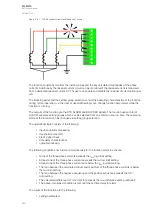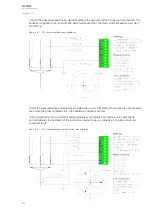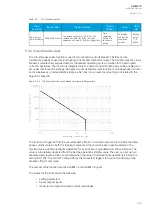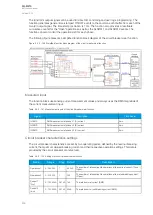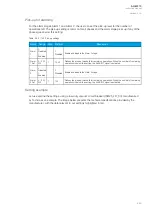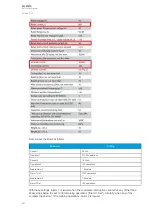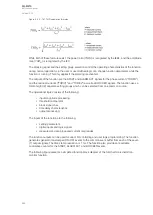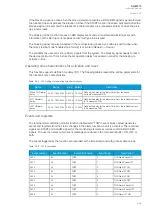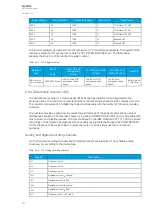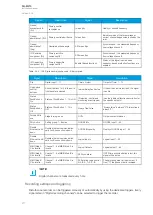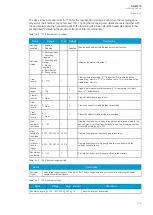
Events and registers
The circuit breaker wear function (abbreviated "CBW" in event block names) generates events and
registers from the status changes in Triggered, Alarm 1 and Alarm 2 signals as well as in internal pick-
up comparators. The user can select which event messages are stored in the main event buffer: ON,
OFF, or both.
The events triggered by the function are recorded with a time stamp and with process data values.
Table. 5.5.2 - 144. Event codes.
Event number
Event channel
Event block name
Event code
Description
3712
58
CBW1
0
CBWEAR1 Triggered
3713
58
CBW1
1
CBWEAR1 Alarm 1 ON
3714
58
CBW1
2
CBWEAR1 Alarm 1 OFF
3715
58
CBW1
3
CBWEAR1 Alarm 2 ON
3716
58
CBW1
4
CBWEAR1 Alarm 2 OFF
The function registers its operation into the last twelve (12) time-stamped registers. The register of the
function records the ON event process data. The table below presents the structure of the function's
register content.
Table. 5.5.2 - 145. Register content.
Date and
time
Event code
Trigger current
All.Op.ITrg
Deduct. Op
Op.Left
dd.mm.yyyy
hh:mm:ss.mss
3712-3716 Descr. Phase currents
on trigger time
Allowed operations
with trigger current
Deducted operations from
the cumulative sum
Operations
left
5.5.3 Total harmonic distortion (THD)
The total harmonic distortion (THD) function is used for monitoring the content of the current harmonic.
The THD is a measurement of the harmonic distortion present, and it is defined as the ratio between
the sum of all harmonic components' powers and the power of the fundamental frequency (RMS).
Harmonics can be caused by different sources in electric networks such as electric machine drives,
thyristor controls, etc. The function's monitoring of the currents can be used to alarm of the harmonic
content rising too high; this can occur when there is an electric quality requirement in the protected
unit, or when the harmonics generated by the process need to be monitored.
The function constantly measures the phase and residual current magnitudes as well as the harmonic
content of the monitored signals up to the 31
st
harmonic component. When the function is activated,
the measurements are also available for the mimic and the measurement views in the HMI carousel.
The user can also set the alarming limits for each measured channel if the application so requires.
The monitoring of the measured signals can be selected to be based either on an amplitude ratio or on
the above-mentioned power ratio. The difference is in the calculation formula (as shown below):
A
AQ
Q-M210
-M210
Instruction manual
Version: 2.04
262
Содержание AQ-M210
Страница 1: ...AQ M210 Motor protection IED Instruction manual ...
Страница 308: ...Figure 7 4 182 Example block scheme A AQ Q M210 M210 Instruction manual Version 2 04 307 ...
Страница 329: ...Figure 8 13 204 Panel cutout dimensions and device spacing A AQ Q M210 M210 Instruction manual Version 2 04 328 ...


